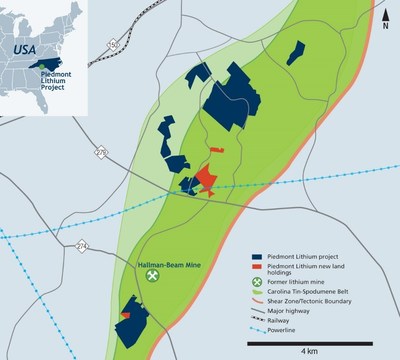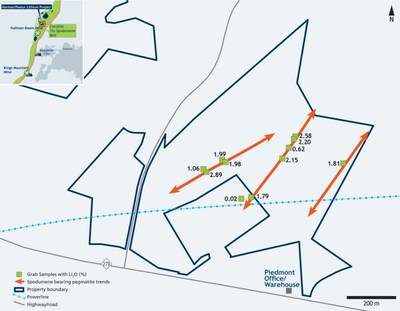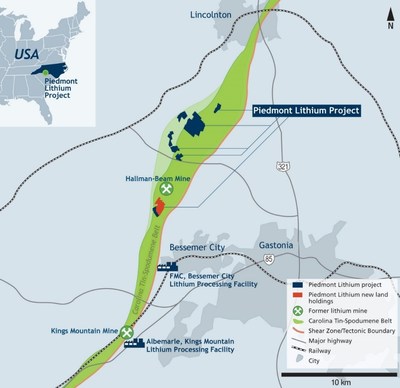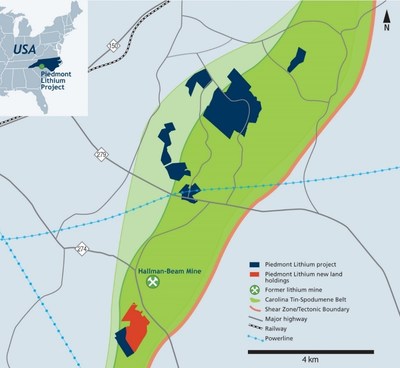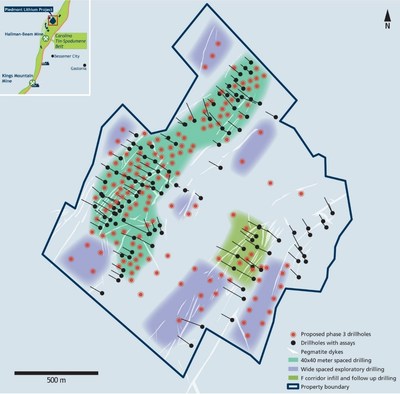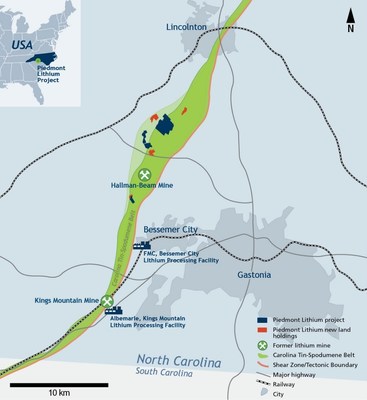NEW YORK, March 14, 2018 /PRNewswire/ —
- Piedmont has received further high-grade assay results including:
- 22.4m of cumulative thickness of mineralization (non-continuous) across 4 pegmatites which includes high grade intercepts of 6.0m @ 1.39% Li2O and3.0m @ 1.59% Li2O in Hole 17-BD-83
- 22.3mof cumulative thickness of mineralization (non-continuous) across 5 pegmatites which includes high grade intercepts of 8.3m @ 1.10% Li2O and5.9m @ 1.53% Li2O in Hole 17-BD-129
- 21.3mof cumulative thickness of mineralization (non-continuous) across 6 pegmatites which includes high grade intercepts of 8.9m@ 1.32% Li2O and 4.0m @ 1.78% Li2O in Hole 17-BD-127
- 19.8mof cumulative thickness of mineralization (non-continuous) across 6 pegmatites which includes high grade intercepts of 5.2m @ 1.79% Li2O and3.0m @ 1.57% Li2O in Hole 17-BD-131
- 18.5m of cumulative thickness of mineralization (non-continuous) across 5 pegmatites which includes high grade intercepts of 3.5m @ 1.50% Li2O and3.1m @ 1.81% Li2O in Hole 17-BD-122
- 16.5m of cumulative thickness of mineralization (non-continuous) across 3 pegmatites which includes high grade intercepts of 4.8m @ 1.45% Li2O and4.5m @ 1.87% Li2O in Hole 17-BD-94
- Phase 3 drilling program is almost 50% complete with 6 drill rigs now on location
- Over 30 holes are currently being assayed with results expected in April
- Maiden resource in on-track for delivery by end of 2nd Quarter 2018
- Results continue to highlight the potential for the Company build a strategic low cost integrated lithium operation in the US
Piedmont Lithium Limited (“Piedmont” or “Company”) is pleased to advise that the Company continues to define high grade lithium mineralisation from its properties in the Carolina Tin-Spodumene Belt (“TSB“) in North Carolina, United States. The Company has received the assay results from the final 17 holes from the Phase 2 campaign and the first 21 holes from the current Phase 3 drilling campaign.
The results build upon the previous drilling completed on the property and continue to show similar high-grade mineralisation and pegmatite intercepts. The Company has six drill rigs on site and has completed 52 holes totalling just over 9,000 meters of its planned 20,000 Phase 3 program. The Company is on schedule to release its maiden JORC compliant resource estimate by the end of the 2nd Quarter 2018.
Keith D. Phillips, President and Chief Executive Officer, said, “These infill drill results are consistent with our expectations, and with six rigs on property we look forward to a steady stream of drilling news over the next several weeks, leading ultimately to a maiden Resource estimate in June and a Scoping Study shortly thereafter.”
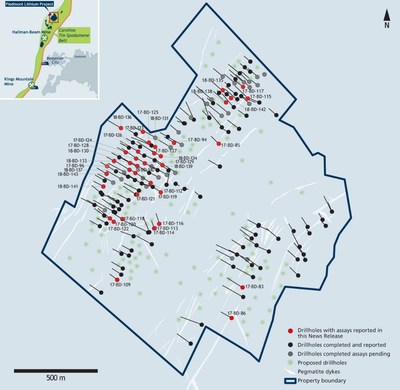
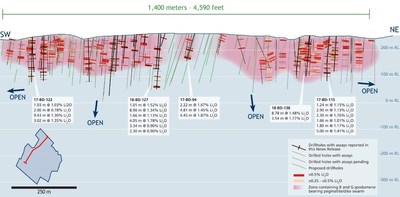
|
For further information, contact: |
|
|
Keith D. Phillips |
Anastasios (Taso) Arima |
|
President & CEO |
Executive Director |
|
T: +1 973 809 0505 |
T: +1 347 899 1522 |
Phase 2 Results and Discussion
The release of the final 17 holes of the Phase 2 campaign which were completed last year continue to show similar high-grade intercepts, as was expected by the Company’s geologists and consultants. These results continue to define mineralization along the four kilometers of strike length within the property, where over 30 spodumene pegmatites have been identified.
The current Phase 3 drilling campaign is focused on infill drilling along the trends defined by the Phase 2 program. These 21 holes (holes 123 to 143) are part of the initial infill drilling required for the compilation of the maiden JORC code compliant resource estimate. These results are consistent with Phase 2 results and are currently being added to the geological model.
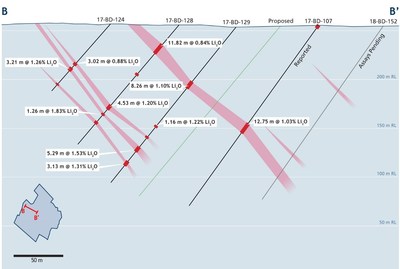
Approximately 13,000m of the 20,000m Phase 3 drilling program will be focused on infill drilling whereas the remaining meterage will test high priority exploration targets on the property, test the along strike and down dip extensions within the current drilling area, and test the potential of the newly acquired properties. The Company is highly encouraged by initial surface mapping and rock chip sampling within these properties and is looking forward to drill testing the targets defined.
The results from last year’s and the current drilling campaign continue to give the Company confidence in being able to define a shallow, surface mineable resource which is strategically located within the historical lithium mining and processing region of the USA. The Company is confident in the ability to release its maiden Mineral Resource estimate in accordance with JORC by the end of the 2nd Quarter 2018 and follow with an integrated Scoping Study in the 3rd Quarter 2018.
About Piedmont Lithium
Piedmont Lithium Limited (ASX: PLL; OTC-Nasdaq Intl: PLLLY) holds a 100% interest in the Piedmont Lithium Project (“Project”) located within the world-class Carolina Tin-Spodumene Belt (“TSB”) and along trend to the Hallman Beam and Kings Mountain mines, historically providing most of the western world’s lithium between the 1950s and the 1990s. The TSB has been described as one of the largest lithium provinces in the world and is located approximately 25 miles west of Charlotte, North Carolina. It is a premier location to be developing and integrated lithium business based on its favourable geology, proven metallurgy and easy access to infrastructure, power, R&D centres for lithium and battery storage, major high-tech population centres and downstream lithium processing facilities.
The Project was originally explored by Lithium Corporation of America which eventually was acquired by FMC Corporation (“FMC”). FMC and Albemarle Corporation (“Albemarle“) both historically mined the lithium bearing spodumene pegmatites within the TSB and developed and continue to operate the two world-class lithium processing facilities in the region which were the first modern spodumene processing facilities in the western world. The Company is in a unique position to leverage its position as a first mover in restarting exploration in this historic lithium producing region with the aim of developing a strategic, U.S. domestic source of lithium to supply the increasing electric vehicle and battery storage markets.
Piedmont, through its 100% owned U.S. subsidiary, Piedmont Lithium Inc., has entered into exclusive option agreements and land acquisition agreements with local landowners, which upon exercise, allow the Company to purchase (or in some cases long-term lease) approximately 1,199 acres of surface property and the associated mineral rights.
Forward Looking Statements
This announcement may include forward-looking statements. These forward-looking statements are based on Piedmont’s expectations and beliefs concerning future events. Forward looking statements are necessarily subject to risks, uncertainties and other factors, many of which are outside the control of Piedmont, which could cause actual results to differ materially from such statements. Piedmont makes no undertaking to subsequently update or revise the forward-looking statements made in this announcement, to reflect the circumstances or events after the date of that announcement.
Competent Persons Statement
The information in this announcement that relates to Exploration Results is based on, and fairly represents, information compiled or reviewed by Mr. Lamont Leatherman, a Competent Person who is a Registered Member of the ‘Society for Mining, Metallurgy and Exploration’, a ‘Recognized Professional Organization’ (RPO). Mr. Leatherman is a consultant to the Company. Mr. Leatherman has sufficient experience that is relevant to the style of mineralization and type of deposit under consideration and to the activity being undertaken to qualify as a Competent Person as defined in the 2012 Edition of the ‘Australasian Code for Reporting of Exploration Results, Mineral Resources and Ore Reserves’. Mr. Leatherman consents to the inclusion in the report of the matters based on his information in the form and context in which it appears.
|
Appendix 1: Summary of Core Drill Hole Intersections |
|||||||||||
|
Hole ID |
Easting |
Northing |
Elev. |
Az. |
Dip |
Depth |
From |
To |
Intercept |
Li2O |
|
|
17-BD-83 |
474186.3 |
3915614 |
258.3 |
300 |
-55 |
185.98 |
29.15 |
30.23 |
1.08 |
1.89 |
|
|
and |
45.73 |
51.69 |
5.96 |
1.39 |
|||||||
|
and |
124.07 |
127.54 |
3.47 |
1.29 |
|||||||
|
and |
159.79 |
171.70 |
11.91 |
1.08 |
|||||||
|
including |
159.79 |
162.79 |
3.00 |
1.59 |
|||||||
|
including |
167.39 |
170.39 |
3.00 |
1.47 |
|||||||
|
17-BD-85 |
474043.4 |
3916471 |
235.2 |
317 |
-48 |
83 |
24.35 |
27.68 |
3.33 |
1.54 |
|
|
and |
29.85 |
35.31 |
5.46 |
0.52 |
|||||||
|
17-BD-86 |
474117.2 |
3915431 |
264.2 |
297 |
-54.5 |
114.3 |
64.15 |
65.43 |
1.28 |
1.43 |
|
|
and |
83.14 |
86.27 |
3.13 |
1.58 |
|||||||
|
17-BD-94 |
473779.1 |
3916477 |
259.167 |
305 |
-54.3 |
121.92 |
65.48 |
67.70 |
2.22 |
1.67 |
|
|
and |
73.81 |
78.62 |
4.81 |
1.45 |
|||||||
|
and |
106.35 |
115.19 |
9.50 |
1.23 |
|||||||
|
including |
110.74 |
115.19 |
4.45 |
1.87 |
|||||||
|
17-BD-96 |
473383.2 |
3916335 |
259.299 |
302 |
-54 |
79.25 |
27.69 |
30.69 |
3 |
0.58 |
|
|
and |
41.06 |
42.14 |
1.08 |
1.05 |
|||||||
|
17-BD-109 |
473442.7 |
3915655 |
264.086 |
307 |
-56.3 |
111.89 |
No Significant Intercepts |
||||
|
17-BD-112 |
473641.5 |
3916239 |
255.302 |
302 |
-55.2 |
170.69 |
23.08 |
25.96 |
2.88 |
0.62 |
|
|
and |
38.36 |
41.01 |
2.65 |
1.32 |
|||||||
|
and |
108.93 |
112.54 |
3.61 |
1.56 |
|||||||
|
and |
137.20 |
141.63 |
4.43 |
0.73 |
|||||||
|
17-BD-113 |
473657.3 |
3915968 |
256.599 |
339 |
-54.5 |
74.98 |
26.21 |
29.55 |
3.34 |
1.16 |
|
|
and |
46.12 |
51.60 |
5.39 |
1.38 |
|||||||
|
17-BD-114 |
3915968 |
473658.4 |
256.75 |
346 |
-53.7 |
83.54 |
19.87 |
24.32 |
4.45 |
1.50 |
|
|
and |
30.69 |
32.27 |
1.56 |
1.24 |
|||||||
|
amd |
46.45 |
48.55 |
2.10 |
0.81 |
|||||||
|
17-BD-115 |
3916742 |
474220.5 |
240.109 |
311 |
-55 |
194.63 |
3.43 |
4.67 |
1.24 |
1.15 |
|
|
and |
26.76 |
29.66 |
2.90 |
1.13 |
|||||||
|
and |
80.23 |
82.53 |
2.30 |
1.76 |
|||||||
|
and |
115.46 |
117.12 |
1.66 |
1.01 |
|||||||
|
and |
131.98 |
133.78 |
1.80 |
1.17 |
|||||||
|
and |
154.39 |
159.39 |
5.00 |
1.41 |
|||||||
|
17-BD-116 |
3915995 |
473691.1 |
248.906 |
342 |
-53.9 |
107.62 |
42.60 |
47.70 |
5.10 |
1.59 |
|
|
including |
42.60 |
44.19 |
1.59 |
2.26 |
|||||||
|
including |
45.19 |
47.70 |
2.51 |
1.80 |
|||||||
|
17-BD-117 |
3916816 |
474188.7 |
248.494 |
311 |
-56.9 |
158.5 |
50.18 |
52.67 |
2.49 |
1.19 |
|
|
and |
59.87 |
61.38 |
1.96 |
1.41 |
|||||||
|
and |
63.70 |
65.70 |
2.00 |
0.54 |
|||||||
|
and |
69.53 |
70.83 |
1.30 |
1.71 |
|||||||
|
and |
80.91 |
82.50 |
1.59 |
1.11 |
|||||||
|
and |
93.22 |
95.35 |
2.13 |
0.48 |
|||||||
|
and |
121.94 |
123.36 |
1.42 |
2.03 |
|||||||
|
17-BD-118 |
3916021 |
473471 |
237.378 |
304 |
-69.8 |
166.73 |
19.32 |
22.14 |
2.82 |
1.34 |
|
|
and |
29.37 |
33.90 |
4.53 |
1.05 |
|||||||
|
including |
30.52 |
32.69 |
2.17 |
1.56 |
|||||||
|
and |
53.04 |
56.59 |
3.55 |
0.73 |
|||||||
|
and |
114.45 |
116.33 |
1.88 |
1.40 |
|||||||
|
and |
128.42 |
131.30 |
2.88 |
1.60 |
|||||||
|
17-BD-119 |
3916183 |
473700.8 |
242.066 |
303 |
-69 |
240.79 |
36.54 |
37.32 |
1.78 |
1.04 |
|
|
and |
59.6 |
62.15 |
2.55 |
0.95 |
|||||||
|
17-BD-120 |
3916007 |
473417.4 |
234.255 |
301 |
-70.7 |
166.73 |
7.62 |
11.96 |
4.34 |
1.16 |
|
|
and |
24.46 |
26.04 |
1.58 |
0.62 |
|||||||
|
and |
58.47 |
60.24 |
1.77 |
0.84 |
|||||||
|
and |
107.50 |
111.17 |
3.67 |
1.22 |
|||||||
|
and |
115.19 |
116.21 |
1.02 |
1.93 |
|||||||
|
and |
141.15 |
144.05 |
2.90 |
1.18 |
|||||||
|
17-BD-121 |
3916171 |
473550 |
242.725 |
308 |
-75.2 |
169.77 |
33.48 |
35.66 |
2.18 |
1.29 |
|
|
and |
53.33 |
55.50 |
2.17 |
0.80 |
|||||||
|
and |
98.96 |
102.79 |
3.83 |
1.07 |
|||||||
|
and |
114.91 |
118.41 |
3.5 |
1.23 |
|||||||
|
17-BD-122 |
3916027 |
473393.2 |
238.138 |
308 |
-54 |
151.18 |
6.10 |
9.14 |
3.04 |
1.35 |
|
|
and |
23.51 |
24.54 |
1.03 |
1.03 |
|||||||
|
and |
45.33 |
47.33 |
2.00 |
0.78 |
|||||||
|
and |
65.26 |
74.69 |
9.43 |
1.30 |
|||||||
|
including |
66.51 |
70.00 |
3.49 |
1.50 |
|||||||
|
including |
71.55 |
74.69 |
3.14 |
1.81 |
|||||||
|
and |
87.66 |
90.68 |
3.02 |
1.35 |
|||||||
|
17-BD-123 |
473595.3 |
3916544 |
262.233 |
295 |
-54.6 |
120.4 |
74.21 |
78.79 |
4.58 |
1.26 |
|
|
and |
109.61 |
113.30 |
3.69 |
1.00 |
|||||||
|
17-BD-124 |
473491.7 |
3916419.95 |
256.543 |
299 |
-49 |
90 |
52.24 |
55.26 |
3.02 |
0.88 |
|
|
and |
58.88 |
62.00 |
3.21 |
1.26 |
|||||||
|
17-BD-125 |
473628.371 |
3916475.88 |
266.036 |
287 |
-48.9 |
162.76 |
113.62 |
117.09 |
3.47 |
0.77 |
|
|
and |
122.99 |
126.41 |
3.42 |
1.32 |
|||||||
|
17-BD-126 |
473565.288 |
3916427.73 |
259.991 |
299 |
-60 |
158 |
55.53 |
57.00 |
1.47 |
1.04
|
|
|
117.75 |
121.26 |
3.51 |
1.04 |
||||||||
|
17-BD-127 |
473660.681 |
3916419.09 |
258.285 |
302 |
-50 |
193.6 |
and |
61.14 |
62.15 |
1.01 |
1.52 |
|
and |
69.96 |
78.86 |
8.90 |
1.34 |
|||||||
|
including |
70.88 |
76.88 |
6.00 |
1.57 |
|||||||
|
And |
151.67 |
153.33 |
1.66 |
1.13 |
|||||||
|
And |
166.12 |
170.17 |
4.05 |
1.78 |
|||||||
|
And |
181.06 |
184.40 |
3.34 |
0.90 |
|||||||
|
and |
188.02 |
190.32 |
2.30 |
0.90 |
|||||||
|
17-BD-128 |
473553.892 |
3916385.26 |
256.128 |
304 |
-49 |
159 |
27.00 |
38.82 |
11.82 |
0.84 |
|
|
including |
27.00 |
31.00 |
4.00 |
1.02 |
|||||||
|
And |
108.22 |
112.75 |
4.53 |
1.20 |
|||||||
|
And |
119.68 |
120.94 |
1.26 |
1.83 |
|||||||
|
17-BD-129 |
473604.5 |
3916357.03 |
254.348 |
300 |
-50.5 |
204.22 |
71.40 |
79.66 |
8.26 |
1.10 |
|
|
including |
76.60 |
79.66 |
3.06 |
1.44 |
|||||||
|
and |
129.88 |
131.04 |
1.16 |
1.22 |
|||||||
|
and |
144.25 |
145.36 |
1.11 |
1.54 |
|||||||
|
and |
157.81 |
166.45 |
8.64 |
1.02 |
|||||||
|
including |
157.81 |
163.10 |
5.29 |
1.53 |
|||||||
|
and |
177.00 |
180.13 |
3.13 |
1.31 |
|||||||
|
18-BD-130 |
473524.057 |
3916354.74 |
258.733 |
297 |
-50.8 |
143 |
28.76 |
32.70 |
3.94 |
1.26 |
|
|
And |
118.95 |
123.82 |
4.87 |
1.46 |
|||||||
|
And |
128.94 |
130.04 |
1.10 |
1.44 |
|||||||
|
and |
134.25 |
136.25 |
2.00 |
1.17 |
|||||||
|
18-BD-131 |
473676.948 |
3916446.33 |
260.138 |
302 |
-54.3 |
224.03 |
47.11 |
50.10 |
2.99 |
1.57 |
|
|
And |
68.06 |
73.25 |
5.19 |
1.79 |
|||||||
|
And |
114.90 |
117.95 |
3.05 |
0.96 |
|||||||
|
And |
151.40 |
153.22 |
1.82 |
1.72 |
|||||||
|
And |
181.06 |
183.53 |
2.47 |
1.11 |
|||||||
|
and |
200.53 |
204.85 |
4.32 |
1.07 |
|||||||
|
18-BD-132 |
473557.044 |
3916337.06 |
252.764 |
300 |
-54.7 |
191.11 |
49.85 |
58.54 |
8.69 |
.95
|
|
|
including |
55.85 |
57.85 |
2.00 |
1.48 |
|||||||
|
and |
145.07 |
149.66 |
4.59 |
1.17 |
|||||||
|
18-BD-133 |
473423.297 |
3916371.17 |
255.788 |
303 |
-58.3 |
80 |
49.83 |
51.73 |
1.90 |
1.09 |
|
|
18-BD-134 |
473701.977 |
3916394.29 |
257.881 |
300 |
-59.3 |
240 |
102.35 |
105.77 |
3.42 |
1.41 |
|
|
and |
224.53 |
233.18 |
8.65 |
0.91 |
|||||||
|
including |
230.10 |
232.10 |
2.00 |
1.23 |
|||||||
|
18-BD-135 |
474068.978 |
3916793.77 |
244.345 |
311 |
-47.6 |
100 |
23.80 |
25.15 |
1.35 |
1.14 |
|
|
and |
29.75 |
38.53 |
8.78 |
1.48 |
|||||||
|
including |
30.05 |
31.05 |
1.00 |
3.56 |
|||||||
|
and |
53.68 |
57.22 |
3.54 |
1.77 |
|||||||
|
18-BD-136 |
473462.509 |
3916563.03 |
262.913 |
303 |
-54 |
141.71 |
No Significant Intercepts |
||||
|
18-BD-137 |
473511.948 |
3916325.59 |
251.474 |
303 |
-51.8 |
178.5 |
33.07 |
40.25 |
7.18 |
1.07 |
|
|
including |
33.07 |
35.58 |
2.51 |
1.66 |
|||||||
|
and |
125.39 |
127.29 |
1.90 |
1.27 |
|||||||
|
168.56 |
169.88 |
1.32 |
1.16 |
||||||||
|
18-BD-138 |
474117.082 |
3916744.6 |
250.31 |
317.5 |
-54.3 |
250 |
47.45 |
48.65 |
1.20 |
1.38
|
|
|
and |
82.72 |
84.48 |
1.76 |
1.38 |
|||||||
|
and |
89.75 |
91.32 |
1.57 |
1.52 |
|||||||
|
and |
95.25 |
99.7 |
4.45 |
0.86 |
|||||||
|
and |
107.76 |
109.95 |
2.19 |
1.11 |
|||||||
|
and |
171.28 |
172.78 |
1.50 |
1.40 |
|||||||
|
18-BD-139 |
473710.658 |
3916341.35 |
259.529 |
297 |
-54.8 |
181.36 |
139.55 |
146.86 |
7.31 |
0.79 |
|
|
18-BD-140 |
473542.155 |
3916292.59 |
255.787 |
302 |
-53.5 |
232.5 |
142.97 |
145.16 |
2.19 |
1.37 |
|
|
and |
156.55 |
164.28 |
7.73 |
0.51 |
|||||||
|
18-BD-141 |
473356.38 |
3916224.64 |
255.251 |
299 |
-55 |
110 |
57.77 |
66.50 |
8.73 |
0.82 |
|
|
including |
61.77 |
65.77 |
4.00 |
1.00 |
|||||||
|
18-BD-142 |
474100.598 |
3916703.93 |
241.752 |
307.1 |
-54.4 |
163 |
101.91 |
106.53 |
4.62 |
1.84 |
|
|
and |
118.60 |
120.11 |
1.51 |
1.10 |
|||||||
|
and |
122.91 |
125.42 |
2.51 |
1.53 |
|||||||
|
18-BD-143 |
473372.454 |
3916294.4 |
254.67 |
298 |
-56.2 |
117 |
32.91 |
34.25 |
1.34 |
1.05 |
|
|
and |
35.16 |
37.19 |
2.03 |
1.46 |
|||||||
|
and |
51.35 |
54.39 |
3.04 |
0.90 |
|||||||
|
Appendix 2: JORC Table 1 Checklist of Assessment and Reporting Criteria |
|||||||
|
Section 1 Sampling Techniques and Data |
|||||||
|
Criteria |
JORC Code explanation |
Commentary |
|||||
|
Sampling techniques |
> Nature and quality of sampling (e.g. cut channels, random chips, or specific specialised industry standard measurement tools appropriate to the minerals under investigation, such as downhole gamma sondes, or handheld XRF instruments, etc.). These examples should not be taken as limiting the broad meaning of sampling. > Include reference to measures taken to ensure sample representivity and the appropriate calibration of any measurement tools or systems used. > Aspects of the determination of mineralisation that are Material to the Public Report. In cases where ‘industry standard’ work has been done this would be relatively simple (e.g. ‘reverse circulation drilling was used to obtain 1 m samples from which 3 kg was pulverised to produce a 30 g charge for fire assay’). In other cases, more explanation may be required, such as where there is coarse gold that has inherent sampling problems. Unusual commodities or mineralisation types (e.g. submarine nodules) may warrant disclosure of detailed information. |
All results reported are from diamond core samples. The core was sawn at an orientation not influenced by the distribution of mineralization within the drill core (i.e. bisecting mineralized veins or cut perpendicular to a fabric in the rock that is independent of mineralization, such as foliation). Diamond drilling provided continuous core which allowed continuous sampling of mineralized zones. The core sample intervals were a minimum of 0.35m and a maximum of 1.5m for HQ or NQ drill core (except in saprolitic areas of poor recovery where sample intervals may exceed 1.5m in length) and took into account lithological boundaries (i.e. sample was to, and not across, major contacts). Standards and blanks were inserted into the sample stream to assess the accuracy, precision and methodology of the external laboratories used. In addition, field duplicate samples were inserted to assess the variability of the mineralisation., The laboratories undertake their own duplicate sampling as part of their internal QA/QC processes. Examination of the QA/QC sample data indicates satisfactory performance of field sampling protocols and assay laboratories providing acceptable levels of precision and accuracy.
|
|||||
|
Drilling techniques |
> Drill type (e.g. core, reverse circulation, open-hole hammer, rotary air blast, auger, Bangka, sonic, etc.) and details (e.g. core diameter, triple or standard tube, depth of diamond tails, face-sampling bit or other type, whether core is oriented and if so, by what method, etc.). |
All diamond drill holes were collared with HQ and were transitioned to NQ once non-weathered and unoxidized bedrock was encountered. Drill core was recovered from surface. Oriented core was collected on select drill holes using the REFLEX ACT III tool by a qualified geologist at the drill rig. The orientation data is currently being evaluated. |
|||||
|
Drill sample recovery |
> Method of recording and assessing core and chip sample recoveries and results assessed. > Measures taken to maximise sample recovery and ensure representative nature of the samples. > Whether a relationship exists between sample recovery and grade and whether sample bias may have occurred due to preferential loss/gain of fine/coarse material. |
The core was transported from the drill site to the logging facility in covered boxes with the utmost care. Once at the logging facility, the following procedures were carried out on the core: 1. Re-aligning the broken core in its original position as closely as possible. 2. The length of recovered core was measured, and meter marks clearly placed on the core to indicate depth to the nearest centimetre. 3. The length of core recovered was used to determine the core recovery, which is the length of core recovered divided by the interval drilled (as indicated by the footage marks which was converted to meter marks), expressed as a percentage. This data was recorded in the database. The core was photographed wet before logged. 4. The core was photographed again immediately before sampling with the sample numbers visible. Sample recovery was consistently good except for zones within the oxidized clay and saprolite zones. These zones were generally within the top 20m of the hole. No relationship is recognized between recovery and grade. The drill holes were designed to intersect the targeted pegmatite below the oxidized zone. |
|||||
|
Logging |
> Whether core and chip samples have been geologically and geotechnically logged to a level of detail to support appropriate Mineral Resource estimation, mining studies and metallurgical studies. > Whether logging is qualitative or quantitative in nature. Core (or costean, channel, etc.) photography. > The total length and percentage of the relevant intersections logged. |
Geologically, data was collected in detail, sufficient to aid in Mineral Resource estimation. Core logging consisted of marking the core, describing lithologies, geologic features, percentage of spodumene and structural features measured to core axis. The core was photographed wet before logging and again immediately before sampling with the sample numbers visible. All the core from the holes reported were logged. |
|||||
|
Sub-sampling techniques and sample preparation |
> If core, whether cut or sawn and whether quarter, half or all core taken. > If non-core, whether riffled, tube sampled, rotary split, etc. and whether sampled wet or dry. > For all sample types, the nature, quality and appropriateness of the sample preparation technique. > Quality control procedures adopted for all sub-sampling stages to maximise representivity of samples. > Measures taken to ensure that the sampling is representative of the in situ material collected, including for instance results for field duplicate/second-half sampling. > Whether sample sizes are appropriate to the grain size of the material being sampled. |
Core was cut in half with a diamond saw. Standard sample intervals were a minimum of 0.35m and a maximum of 1.5m for HQ or NQ drill core, taking into account lithological boundaries (i.e. sample to, and not across, major contacts). The preparation code is CRU21 (crush to 75% of sample <2mm) and PUL45 (pulverize 250g to 85% <75 microns). A CRM or coarse blank was included at the rate of one for every 20 drill core samples (i.e. 5%). Sampling precision is monitored by selecting a sample interval likely to be mineralized and splitting the sample into two ¼ core duplicate samples over the same sample interval. These samples are consecutively numbered after the primary sample and recorded in the sample database as “field duplicates” and the primary sample number recorded. Field duplicates were collected at the rate of 1 in 20 samples when sampling mineralized drill core intervals Samples were numbered sequentially with no duplicates and no missing numbers. Triple tag books using 9-digit numbers were used, with one tag inserted into the sample bag and one tag stapled or otherwise affixed into the core tray at the interval the sample was collected. Samples were placed inside pre-numbered sample bags with numbers coinciding to the sample tag. Quality control (QC) samples, consisting of certified reference materials (CRMs), were given sample numbers within the sample stream so that they are masked from the laboratory after sample preparation and to avoid any duplication of sample numbers. |
|||||
|
Quality of assay data and laboratory tests
|
> The nature, quality and appropriateness of the assaying and laboratory procedures used and whether the technique is considered partial or total. > For geophysical tools, spectrometers, handheld XRF instruments, etc., the parameters used in determining the analysis including instrument make and model, reading times, calibrations factors applied and their derivation, etc. > Nature of quality control procedures adopted (e.g. standards, blanks, duplicates, external laboratory checks) and whether acceptable levels of accuracy (i.e. lack of bias) and precision have been established.
|
All samples from the Phase II and Phase III drilling were shipped to the SGS laboratory in Lakefield, Ontario. The preparation code was CRU21 (crush to 75% of sample <2mm) and PUL45 (pulverize 250g to 85% <75 microns). The analyses code was GE ICM40B (multi-acid digestion with either an ICP-ES or ICP-MS finish), which has a range for Li of 1 to 10,000 (1%) ppm Li. The over-range method code for Li >5,000 ppm is GE ICP90A, which uses a peroxide fusion with an ICP finish, and has lower and upper detection limits of 0.001 and 5% respectively. Starting in August 2017, samples were switched to being analysed using GE ICP90A Li only and then to GE ICP91A Li only. Bulk Densities are collected from drill holes (one host rock and one mineralized rock) using analyses code GPHY04V. Phase I samples were shipped to the Bureau Veritas minerals laboratory in Reno, Nevada. The preparation code was PRP70-250 (crush to 70% of sample <2mm, pulverize 250g to 85% <75 microns). The analysis code was MA270 (multi-acid digestion with either an ICP-ES or ICP-MS finish), which has a range for Li of 0.5 to 10,000 ppm (1%) Li. This digestion provides only partial analyses for many elements in refractory minerals, including Ta and Nb. It does not include analyses for Cs. The over-range method code for Li>10,000 ppm is PF370, which uses a peroxide fusion with an ICP-ES finish and has lower and upper detection limits of 0.001 and 50%, respectively. The laboratory was instructed to implement the over-range method in all samples that exceed 5,000 ppm Li to allow for poor data precision near the upper limit of detection using MA270. Historical samples (holes 09-BD-01 through 10-BD-19) were submitted to ALS Vancouver for analysis. Accuracy monitoring was achieved through submission and monitoring of certified reference materials (CRMs). Sample numbering and the inclusion of CRMs was the responsibility of the project geologist submitting the samples. A CRM or coarse blank was included at the rate of one for every 20 drill core samples (i.e. 5%). The CRMs used for this program were supplied by Geostats Pty Ltd of Perth, Western Australia. Details of the CRMs are provided below. A sequence of these CRMs covering a range in Li values and, including blanks, were submitted to the laboratory along with all dispatched samples so as to ensure each run of 100 samples contains the full range of control materials. The CRMs were submitted as “blind” control samples not identifiable by the laboratory. Details of CRMs used in the drill program (all values ppm): |
|||||
|
CRM |
Manufacturer |
Lithium |
1 Std Dev |
||||
|
GTA-01 |
Geostats |
3132 |
129 |
||||
|
GTA-02 |
Geostats |
1715 |
64 |
||||
|
GTA-03 |
Geostats |
7782 |
175 |
||||
|
GTA-04 |
Geostats |
9275 |
213 |
||||
|
GTA-06 |
Geostats |
7843 |
126 |
||||
|
GTA-09 |
Geostats |
4837 |
174 |
||||
|
Sampling precision was monitored by selecting a sample interval likely to be mineralized and splitting the sample into two ¼ core duplicate samples over the same sample interval. These samples were consecutively numbered after the primary sample and recorded in the sample database as “field duplicates” and the primary sample number recorded. Field duplicates were collected at the rate of 1 in 20 samples when sampling mineralized drill core intervals. Random sampling precision was monitored by splitting samples at the sample crushing stage (coarse crush duplicate) and at the final sub-sampling stage for analysis (pulp duplicates). The coarse, jaw-crushed, reject material was split into two preparation duplicates, sometimes referred to as second cuts, crusher or preparation duplicates, which were then pulverized and analysed separately. These duplicate samples were selected randomly by the laboratory. Analytical precision was also monitored using pulp duplicates, sometimes referred to as replicates or repeats. Data from all three types of duplicate analyses was used to constrain sampling variance at different stages of the sampling and preparation process. Examination of the QA/QC sample data indicates satisfactory performance of field sampling protocols and assay laboratories providing acceptable levels of precision and accuracy. |
|||||||
|
Verification of sampling and assaying |
> The verification of significant intersections by either independent or alternative company personnel. > The use of twinned holes. > Documentation of primary data, data entry procedures, data verification, data storage (physical and electronic) protocols. > Discuss any adjustment to assay data. |
Multiple representatives of Piedmont Lithium, Inc. have inspected and verified the results. CSA has conducted multiple site visits. Dennis Arne (Managing Director -Principal Consultant) toured the site, facilities and reviewed core logging and sampling workflow as well as Leon McGarry (Senior Resource Geologist). Each provided comments on how to improve our methods and have been addressed. Verification core samples were collected by Leon McGarry with assays pending. No holes were twinned. Ten-foot rods and core barrels were used, the core was converted from feet to meters. Li% was converted to Li2O by multiplying Li% by 2.153. |
|||||
|
Location of data points |
> Accuracy and quality of surveys used to locate drill holes (collar and down-hole surveys), trenches, mine workings and other locations used in Mineral Resource estimation. > Specification of the grid system used. > Quality and adequacy of topographic control. |
Drill collars were located with the Trimble Geo 7 which resulted in accuracies <1m. All coordinates were collected in State Plane and re-projected to Nad83 zone17 in which they are reported. Drill hole surveying was performed on each hole using a REFLEX EZ-Trac multi-shot instrument. Readings were taken approx. every 15 meters (50 feet) and recorded depth, azimuth, and inclination. |
|||||
|
Data spacing and distribution |
> Data spacing for reporting of Exploration Results. > Whether the data spacing and distribution is sufficient to establish the degree of geological and grade continuity appropriate for the Mineral Resource and Ore Reserve estimation procedure(s) and classifications applied. > Whether sample compositing has been applied. |
For selected areas, the drill spacing is approximately 40 to 80 m along strike and down dip. This spacing is sufficient to establish continuity in geology and grade for this pegmatite system. Composite samples are reported in Li2O%, this is calculated by multiplying drill length by Li2O for each sample; then the weighted averages for multiple samples are totalled and divided by the total drill length for the selected samples
|
|||||
|
Orientation of data in relation to geological structure |
> Whether the orientation of sampling achieves unbiased sampling of possible structures and the extent to which this is known, considering the deposit type. > If the relationship between the drilling orientation and the orientation of key mineralised structures is considered to have introduced a sampling bias, this should be assessed and reported if material. |
The pegmatite dikes targeted trend northeast and dip to the southeast, drillholes were designed, oriented to the northwest with inclinations ranging from -45 to -80 degrees, to best intersect the tabular pegmatite bodies as close to perpendicularly as possible. |
|||||
|
Sample security |
> The measures taken to ensure sample security. |
Drill core samples were shipped directly from the field by the project geologist in sealed rice bags or similar containers using a reputable transport company with shipment tracking capability so that a chain of custody can be maintained. Each bag was sealed with a security strap with a unique security number. The containers were locked in a shed if they were stored overnight at any point during transit, including at the drill site prior to shipping. The laboratory confirmed the integrity of the rice bag seals upon receipt |
|||||
|
Audits or reviews |
> The results of any audits or reviews of sampling techniques and data. |
CSA Global developed a “Standard Operating Procedures” manual in preparation for the drilling program. CSA global reviews all logging and assay data, as well as merges all data in to database that is held off site. CSA has conducted multiple site visits. Dennis Arne (Managing Director -Principal Consultant) toured the site and facilities as well as Leon McGarry (Senior Resource Geologist). Each provided comments on how to improve our methods and have been addressed. Verification core samples were collected by Leon McGarry. |
|||||
|
Section 2 Reporting of Exploration Results |
||
|
Criteria |
JORC Code explanation |
Commentary |
|
Mineral tenement and land tenure status |
> Type, reference name/number, location and ownership including agreements or material issues with third parties such as joint ventures, partnerships, overriding royalties, native title interests, historical sites, wilderness or national park and environmental settings. > The security of the tenure held at the time of reporting along with any known impediments to obtaining a licence to operate in the area. |
Piedmont, through its 100% owned subsidiary, Piedmont Lithium, Inc., has entered into exclusive option agreements with local landowners, which upon exercise, allows the Company to purchase (or long term lease) approximately 1200 acres of surface property and the associated mineral rights from the local landowners. There are no known historical sites, wilderness or national parks located within the Project area and there are no known impediments to obtaining a licence to operate in this area. |
|
Exploration done by other parties |
> Acknowledgment and appraisal of exploration by other parties. |
The Project is focused over an area that has been explored for lithium dating back to the 1950’s where it was originally explored by Lithium Corporation of America which was subsequently acquired by FMC Corporation. Most recently, North Arrow explored the Project in 2009 and 2010. North Arrow conducted surface sampling, field mapping, a ground magnetic survey and two diamond drilling programs for a total of 19 holes. Piedmont Lithium, Inc. has obtained North Arrow’s exploration data. |
|
Geology |
> Deposit type, geological setting and style of mineralisation. |
Spodumene pegmatites, located near the litho tectonic boundary between the inner Piedmont and Kings Mountain belt. The mineralization is thought to be concurrent and cross-cutting dike swarms extending from the Cherryville granite, as the dikes progressed further from their sources, they became increasingly enriched in incompatible elements such as Li, tin (Sn). The dikes are considered to be unzoned.
|
|
Drill hole Information |
> A summary of all information material to the understanding of the exploration results including a tabulation of the following information for all Material drill holes: > easting and northing of the drill hole collar > elevation or RL (Reduced Level – elevation above sea level in metres) of the drill hole collar > dip and azimuth of the hole > down hole length and interception depth > hole length. > If the exclusion of this information is justified on the basis that the information is not Material and this exclusion does not detract from the understanding of the report, the Competent Person should clearly explain why this is the case. |
Details of all reported drill holes are provided in Appendix 1 of this report.
|
|
Data aggregation methods |
> In reporting Exploration Results, weighting averaging techniques, maximum and/or minimum grade truncations (e.g. cutting of high grades) and cut-off grades are usually Material and should be stated. > Where aggregate intercepts incorporate short lengths of high grade results and longer lengths of low grade results, the procedure used for such aggregation should be stated and some typical examples of such aggregations should be shown in detail. > The assumptions used for any reporting of metal equivalent values should be clearly stated. |
All intercepts reported are for down hole thickness not true thickness. Weighted averaging was used in preparing the intercepts reported. The drill intercepts were calculated by adding the weighted value (drill length x assay) for each sample across the entire pegmatite divided by the total drill thickness of the pegmatite. For each mineralized pegmatite, all assays were used in the composite calculations with no upper or lower cut-offs. Mineralized pegmatite is defined as spodumene bearing pegmatite. Intercepts were reported for entire pegmatites, taking into account lithological boundaries (i.e. sample to, and not across, major contacts), with additional high-grade sub intervals reported from the same pegmatite. In the case where thin wall rock intervals were included, a value of 0% Li2O was inserted for the assay value, thus giving that individual sample a weighted value of 0% Li2O. Cumulative thicknesses are reported for select drill holes. These cumulative thicknesses do not represent continuous mineralized intercepts. The cumulative thickness for a drill hole is calculated by adding the drill widths of two or more mineralized pegmatites encountered in the drill hole, all other intervals are omitted from the calculation. Li% was converted to Li2O% by multiplying Li% by 2.153. |
|
Relationship between mineralisation widths and intercept lengths |
> These relationships are particularly important in the reporting of Exploration Results. > If the geometry of the mineralisation with respect to the drill hole angle is known, its nature should be reported. > If it is not known and only the down hole lengths are reported, there should be a clear statement to this effect (e.g. ‘down hole length, true width not known’). |
Drill intercepts are reported as Li2O% over the drill length, not true thickness. The pegmatites targeted strike northeast-southwest and dip moderately to the southeast. All holes were drilled to the northwest and with inclinations ranging between -45 and -80 |
|
Diagrams |
> Appropriate maps and sections (with scales) and tabulations of intercepts should be included for any significant discovery being reported These should include, but not be limited to a plan view of drill hole collar locations and appropriate sectional views. |
Appropriate diagrams, including a drill plan map and cross-section, are included in the main body of this report. |
|
Balanced reporting |
> Where comprehensive reporting of all Exploration Results is not practicable, representative reporting of both low and high grades and/or widths should be practiced to avoid misleading reporting of Exploration Results. |
All of the relevant exploration data for the Exploration Results and available at this time has been provided in this report. |
|
Other substantive exploration data |
> Other exploration data, if meaningful and material, should be reported including (but not limited to): geological observations; geophysical survey results; geochemical survey results; bulk samples – size and method of treatment; metallurgical test results; bulk density, groundwater, geotechnical and rock characteristics; potential deleterious or contaminating substances. |
Eleven thin section samples were collected and submitted to Vancouver Petrographic for preparation, mineral identification and description. The Petrographic report identifies the primary mineralogy as quartz, plagioclase (albite), clinopyroxene (spodumene), K-spar and white mica. Variable amounts of alteration were identified in the pegmatite samples. One sample of the host rock was submitted and identified as a metadiorite. Thirteen samples from the Phase 1 drilling have been analysed by Semi Quantitative XRD (ME-LR-MIN-MET-MN-DO3) by SGS Mineral Services. Within all thirteen samples, spodumene was identified. Spodumene ranged between 5 and 38.6 wt%. The primary mineralogy of the pegmatite was identified as quartz, albite, spodumene, microcline and muscovite. Bulk Densities are collected from each of the Phase II drill holes (one host rock and one mineralized rock) using analyses code GPHY04V. Composite samples of ore intercepts from the Phase 1 drilling have been submitted to North Carolina State Minerals Research Lab for bench scale spodumene concentrate testing. Results pending. |
|
Further work |
> The nature and scale of planned further work (e.g. tests for lateral extensions or depth extensions or large-scale step-out drilling). > Diagrams clearly highlighting the areas of possible extensions, including the main geological interpretations and future drilling areas, provided this information is not commercially sensitive. |
The Phase II drilling program consisted of 93 holes totalling 12,262m has been completed. After evaluation of all of the Phase II data Piedmont decided to conduct additional Phase III drilling to define the Company’s maiden Mineral Resource estimate in 2018. |
![]() View original content with multimedia:http://www.prnewswire.com/news-releases/piedmont-continues-to-define-high-grade-lithium-mineralisation-in-north-carolina-300614360.html
View original content with multimedia:http://www.prnewswire.com/news-releases/piedmont-continues-to-define-high-grade-lithium-mineralisation-in-north-carolina-300614360.html
SOURCE Piedmont Lithium Limited

